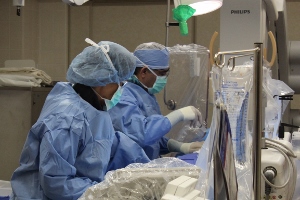
McLaren Flint’s structural heart program physicians not only replace aortic and mitral valves but also repair them. When put in place, aortic and mitral valves are sewn to the patient’s heart valve opening, creating a seal for blood to flow properly.
A repair is needed if a paravalvular leak occurs. This is caused when space grows between the patient’s heart tissue and the valve replacement. The condition occurs over a long period of time in 5-10 percent of aortic valves and 7-17 percent of mitral valves.
“Patients who receive these types of valve replacements usually have serious health issues that make them a poor candidate for open heart surgical procedures,” said Ahmad Munir, MD, a structural heart specialist who performed the first valve repair at McLaren Flint. “It makes sense that their anatomy can weaken over time or calcium can build up in the heart causing the separation of the valve away from the heart tissue.”
The repair is made with a small plug that resembles a Life Savers candy. The procedure takes place through a small incision in the groin in which the device is tunnelled up to the heart by way of a catheter. The patient has a one-day stay in the hospital and experiences a short recovery.
“The future of heart disease procedures continues to transition more and more toward minimally invasive techniques,” says Dr. Munir. “Technology is truly amazing, and it only continues to get better. It is exciting to offer high-risk patients treatment options for longer, better quality lives.”
For more information, call the Michigan Heart Valve Institute located at McLaren Flint (810) 342-2590.